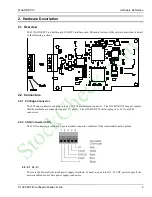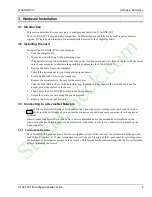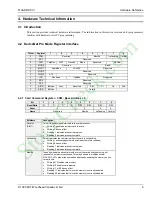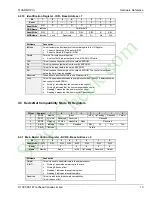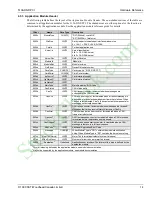
5136-DNP-PCI
Hardware Reference
© 1999 SST/Woodhead Canada Limited
16
4.6.5 Configure Interrupts
1.
Set IrqPending in BCR0 to clear the interrupt latch.
2.
If physical interrupts are required, write the interrupt level to IrqLevel in BCR2. See section 4.3.3.
3.
If a physical interrupt test is required, perform the necessary initialization to receive the test interrupt and
set IrqPending in BCR0 to enable physical interrupt generation.
4.6.6 Start the application module
1.
Set WDInh in BCR2 to disable the watchdog timer.
2.
The card self-diagnostic will fail if the watchdog is enabled during startup.
3.
Toggle (clear, set) CardRun in BCR2 twice to start the card processor.
4.
Start a timeout timer (typically 1-2 seconds).
5.
Wait until ModuleType in the Application Module Header is set to either ‘DN’ or ‘ER’, or the timeout
timer expires.
4.6.7 Check module startup results
1.
If ModuleType in the Application Module Header does not contain ‘DN’ or ‘ER’ the application module
failed to start.
2.
Refer to section 4.6.10 for further instructions.
3.
If ModuleType contains ‘ER’, the card diagnostic has detected an error.
4.
The error string in the Message area of the Application Module Header provides details. Refer to section
4.6.10 for further instructions.
5.
If ModuleType contains ‘DN’, the card processor is operating correctly.
4.6.8 Test Interrupt Generation
The module startup process generates a test interrupt.
1.
Read BCR0 and verify that IrqPending is set.
2.
If an interrupt handler was installed, verify that the test interrupt was received.
3.
Set IrqPending in BCR0 to clear the interrupt latch.
4.6.9 Successful completion
1.
Clear WDInhibit in BCR2 to enable the watchdog timer.
2.
Set HealthGrn in BCR2 to change the Health LED from red to green.
3.
If interrupts are required, set IrqPending in BCR0 to enable physical interrupt generation.
4.6.10 If something goes wrong
1.
Write 0x00 to each of the configuration registers (BCR0, BCR1 and BCR2).
2.
Report the nature of the error to the user.
StockCheck.com

